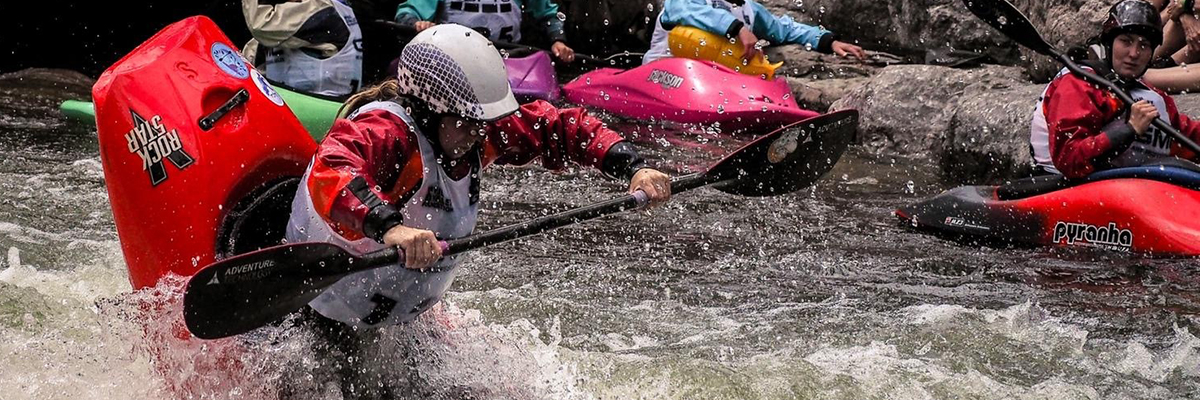Posted by: Shauna Farnell
Unfolding in the churning waves of Gore Creek in the heart of Vail Village, freestyle kayaking has long been the centerpiece of the GoPro Mountain Games.
As hundreds of spectators gather around to watch paddlers defy gravity by paddling into a wave and then flipping, spinning, bouncing on the noses and tails of their boats, whispers of “how do they do that?” or, “she must have abs of steel,” or, “that looks impossible” flutter through the crowd.
As two of the sport’s most successful athletes will tell you, freestyle requires a step-by-step progression and a special kind of paddler.
“It’s probably similar to a lot of sports,” says former freestyle kayak World Champion Nick Troutman, a long-time fixture at the GoPro Mountain Games. “What takes a biker to go from riding cross country to hitting jumps, what takes a skier from going down the mountain to hitting rails or the park? Whether it be a desire for flight, the feeling of being separated from gravity or a way to be creative and try new things, freestyle gives you the opportunity to showcase your own style.”
Of course, not just any paddler can go from navigating whitewater to launching a McNasty (a type of front flip) in Gore Creek.
“For a lot of people who initially get into kayaking, the goal is to keep yourself upright, get downstream and keep your hair dry,” says Emily Jackson, reigning champion of the Mountain Games’ women’s Kayak Freestyle competition. “Freestyle comes after you get confident when you tip over, knowing you can get back up. You spend a lot of time upside down in freestyle, so when you don’t know how to get right-side up, it doesn’t look like something very enticing for a lot of people.”
Dialing in the roll
Perhaps the most successful power couple in the paddling world, Jackson and Troutman are slowly guiding their children, Tucker, 8, and Parker, 5, to become comfortable in their own pint-sized playboats. While Parker is too small to even consider working her way up to freestyle tricks, Tucker has embarked on the pivotal roll phase.
“So much opens up with anyone who’s got a good roll. Tucker is very timid, but he’s got a great roll,” Jackson says. “We play a game and start goofing off in the water and he starts banging out rolls. He has the confidence in his roll when he chooses to. That’s the thing in kayaking, you can flip over when you don’t mean to. As a kid that can be hard. He’s keen and very competitive. Sometimes it takes getting him out with another kid his age and get him surfing.”
Strength and practice
While professional freestyle kayakers are unquestionably built like action figures and indeed spend time working out and cross-training in other sports, sheer strength does not always lead to success.
“You can finesse a lot with the water,” Jackson says. “One of the girls out here is so good at freestyle, but a couple of years ago, she couldn’t do pushups. I’ve always been really strong and can muscle my way through. I can’t just rely on that only. Finesse is something I’m still working on. Of course, doing cross fit and a lot of cardio helps. It adds to the sport, it doesn’t subtract.”
That said, there’s no such thing as learning to freestyle kayak in a gym.
“Doing the activity is the best way to get in shape for that activity,” Troutman says. “If you look at climbers, I’m sure they do chin-ups and they’ve got great upper body strength, but they developed that by climbing. Halfpipe snowboarders spend a lot of time in a foam pit or trampoline, but it’s the time on their snowboard that really matters. It’s the same in kayaking. We have core strength, back and arm strength. Paddling is the best way to get those areas into shape. Friends of mine say, I’m not in good enough shape to kayak. To get there, you have to kayak.”
Surfs up
Surfing in a kayak is the same as on a board. It involves balancing on a wave such as the one in Gore Creek or any whitewater park. As paddlers become balanced and comfortable, they begin carving and maneuvering their boards, figuring out how shifting their weight allows them to spin and even flip.
“You have to start in a freestyle kayak. You think of it like a surfboard. You see people try to stand up on a wave. You’re standing up, then you’re carving. In a kayak, you spin a 360, you do a loop, plug your bow to the green water, shoot up and land on your hull,” Jackson says. “The transition comes in that initial feeling of, I’m sitting on this wave surfing. I’m actually in control. It comes with asking is the water controlling you or are you in control? The only way to get into freestyle kayaking is when you’re in control.”
The winning formula
In freestyle kayak competition, one of the telltale signs that paddlers are not in control is when the water flushes them down stream and they have to expend precious time and energy chugging back up to the “hole” where they can continue with their tricks. Staying in that sweet spot and putting together the most impressive, technical combinations is what it takes to win, and that gets tougher from year to year as the talent soars.
“In the women’s competition, it’s going to take staying in the feature and not flushing out,” Jackson says. “I think we’ll see big air – you get bonuses for height. I think no matter what, among both men and women, we’re going to see some tight scores this weekend.”
As a judged event, distinctive and impressive style is what prevails.
“Coming back to the idea of what is freestyle, there’s different athletes that have different strengths,” Troutman says. “Some people might be good at technical stuff. Another athlete might be good at amplitude and aim for getting as many bonuses as possible. Another might be good at getting the clean. It’s tricky to pinpoint, exactly. It comes down to what the judges like.”
Share this Story:






















